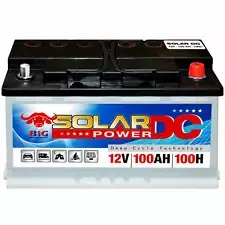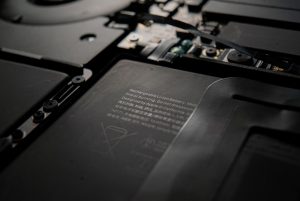
Battery sizing
The battery type recommended for use in solar systems is the deep cycle battery. Deep cycle batteries are specifically designed to be discharged to low energy levels and rapidly recharged or cycle charged and discharged day after day for years. The battery should be large enough to store sufficient energy to operate the appliances at night and cloudy days. To figure out the size of your battery, I could throw a bunch of maths at you: Battery Capacity (Ах) = (Total Watt hours per day x Days of autonomy) Divided by (0.85 x 0.6 x nominal battery voltage), 0.85 for battery loss, 0.6 for depth of discharge. These numbers vary depending on your battery type, температура, так далее. In reality every location is different, and power usage can fluctuate according to the users habits, most of that math gives just a basic impression.
Batteries have different Rating for amper-hours: c5, c12, c50, and c100. This identifies the amount of time in hours over which that amount of amper-hours can be drawn. The higher the number the less power you can drain “on the short”. бывший. “A 320 Ah c50” battery will most likely only have 220 Ah available for c5. Sneaky advertisers love to give higher C ratings in their advertised numbers to inflate the battery size. You should always look for c5 or c12 ratings.
Which system voltage to use?
Usually devices are available for 12Volt, 24Вольт или 48 Вольт.
A lot of devices can be multi voltage, for charge controllers it is common that they can run 12v and 24v. Changing system voltage later on might be tricky as it involves changing a majority of parts and a recalculation of cable diameters.
12 вольт
If you’re planing only a small system 12Volt means you can work with just one battery. You will find a large selection of devices that will work on 12v as it is the standard provided by cars and caravans.
Downside is you need to make the cables very thick if you plan to connect a bigger inverter or a lot of solar panels.
24 вольт
Standard used in trucks. Still offers a reasonable selection of available devices for direct connection. You will need to have at least 2x12V batteries the same size connected for smaller setups, or a proper deep cycle battery for larger setups. The required cable diameter is already less then half compared to 12V. Still if you have a solar panel block with 1400Watts with a 50 meter connection line you looking at 16mm² diameter cables.
48 вольт
Standard used in heavy machinery such as forklifts.
A complex setup with standard batteries, highly recommended to use a deep cycle battery for 48v. Only specialised utilities and devices available for direct connection. Very small cable diameters. The more distance you need to cover with your connection lines and the more power you want to connect to your battery, the more sense it makes to go with a 48V system.
Recommended minimum battery size
*This is assuming a 24Volt system with a c5 rated battery. If you use 12Volt double the numbers, at 48Volt half the numbers, if you use a different C rating add about 15% for c12, о 35% for c50 and so on.
- Small cabin, a better tent
1-2 Led lights, 25 watts entertainment, USB charger for phone.
150 Ah c5 - Caravan, mobile home, bigger cabin
4-5 Led lights, 50Watt fridge, 100Watt entertainment, power efficient water pump.
320 Ah c5 - Small house
3-4 rooms, 10 led lights, 75Watt fridge, 150Watt entertainment, power efficient water pump.
720Ah c5 - Normal house
6-7 Rooms, 20 Led lights, 150Watt fridge, 100Watt freezer, water pump, 250watt entertainment, так далее.
1200Ah c5
Battery types
Battery types that can be used for solar can be ruffly split into 4 sections.
Car/truck batteries (Monoblock batteries), solar batteries in car/truck battery housings(AGM batteries), single cell batteries (Deep-cycle batteries) and lithium batteries. Aside from lithium batteries, all other types are available either with distilled water or gel as electrolyte. Gel is generally more expensive but does not require maintenance.
Monoblock batteries
These are the most common and simple ones that exist, and are most similar to those that a truck has. They have the shortest lifespan, о 600 cycles with 40% and less capacity. Definitely the cheapest. They are used for small photovoltaic systems where devices without motors are connected (lighting, компьютеры, TVs, telecommunications, signalling systems, и т.п.). Running motor powered devices (washing machines, dishwashers, drills, water pumps, и т.п.) is not recommended. Annual maintenance needed for electrolytes, they also require a certain amount of ventilation. Their useful life is around 4-5 годы.

AGM batteries
This type of battery is used when there is a need for more peak power, as engine starters, or generally when a longer lifespan is required. AGM batteries have a longer life than monoblock batteries, о 1.000 cycles. Usually they are more stable and resistant than monoblock batteries, as they withstand vibrations and shocks better. Higher loading charge and therefore shorter charging times is another advantage.

Deep-cycle batteries
Deep-cycle batteries / Single cell batteries
This is the recommended battery type for going offgrid !
These batteries are used only in heavy equipment. They consist of multiple cells that are wired parallel or inline depending on needs. Forklifts are a popular example, other usages are emergency power supplies for hospitals. These things are big, heavy and somewhat expensive. But they have the best quality to price ratio and have a useful life of around 20 годы. They are designed for facilities with a large daily consumption. Although the price is higher, it is highly worth the investment considering the vastly increased battery life. Another advantage of stationary batteries is that they allow deep daily discharge cycles. You can charge them with immense amounts of energy in very short time. Annual maintenance needed for electrolytes, they also require a certain amount of ventilation.

Lithium batteries
These types of batteries are lighter, compact and with fast charging times. They do not require much if any maintenance.
The problem is that; they are expensive, most older inverters and charge controllers cant work with them, and older/cheap models tend to go on fire randomly.
There is some advantages with this battery type, they allow almost 100% of their power to be discharged, the charging process is faster and allows up to 6000 discharge cycles at 90%.
LiFePO4 is not quite as energy-dense as lithium manganese cobalt and the like. One certainly should not cut it up while it’s fully-charged, but a catastrophically compromised LiFePO4 cell should not vent fire.
A disadvantage of LiFePO4 as well as most other litium based batteries is their inability to be charged below 0° C.

Battery maintenance
You can find a more detailed look at Annual maintenance of lead acid batteries in our проекты раздел.